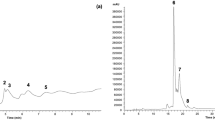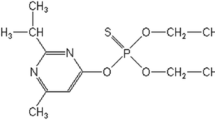Abstract
In the present study we show that repeated exposure of the rat intestinal epithelial cell line IEC-18 to 2-hydroxyamino-1-methyl-6-phenylimidazo[4,5-b]pyridine (N-OH-PhIP), from a toxicological point of view the most relevant phase-1 metabolite of 2-amino-1-methyl-6-phenylimidazo[4,5-b]pyridine (PhIP, the main heterocyclic aromatic amine present in processed meat), led to the selection of N-OH-PhIP-resistant IEC-18 cells. This phenomenon was accompanied by a fivefold increase in total glutathione S-transferase (GST) activity, measured with the broad-spectrum substrate 1-chloro-2,4-dinitrobenzene, in the N-OH-PhIP-resistant IEC-18 cells. Furthermore, a Western blotting analysis revealed that the expression of GST subunits A1, A3, A4, M1 and P1 was enhanced in the N-OH-PhIP-resistant IEC-18 cells.
Similar content being viewed by others
Abbreviations
- CDNB:
-
1-chloro-2,4-dinitrobenzene
- CYP:
-
cytochrome P450
- DMSO:
-
dimethyl sulfoxide
- GST:
-
glutathione S-transferase
- HAA:
-
heterocyclic aromatic amine
- MTT:
-
3-[4,5-dimethylthiazole-2-yl]-2,5-diphenyl tetrazolium bromide
- N-OH-PhIP:
-
2-hydroxyamino-1-methyl-6-phenylimidazo[4,5-b]pyridine
- NAT:
-
N-acetyltransferase
- PhIP:
-
2-amino-1-methyl-6-phenylimidazo[4,5-b]pyridine
- RT-PCR:
-
reverse transcription–polymerase chain reaction
- SULT:
-
sulfotransferase
References
Barnouin K, Leier I, Jedlitschky G, et al. Multidrug resistance protein-mediated transport of chlorambucil and melphalan conjugated to glutathione. Br J Cancer. 1998;77:201–9.
Bradford MM. A rapid and sensitive method for the quantitation of microgram quantities of protein utilizing the principles of protein–dye binding. Anal Biochem. 1976;72:248–54.
Brooks RA, Gooderham NJ, Zhao K, et al. 2-Amino-1-methyl-6-phenylimidazo[4,5-b]pyridine is a potent mutagen in the mouse small intestine. Cancer Res. 1994;54:1665–71.
Buonarati MH, Tucker JD, Minkler JL, Wu RW, Thompson LH, Felton JS. Metabolic activation and cytogenetic effects of 2-amino-1-methyl-6-phenylimidazo[4,5-b]pyridine (PhIP) in Chinese hamster ovary cells expressing murine cytochrome P450 IA2. Mutagenesis. 1991;6:253–9.
Chen G, Zhang D, Jing N, Yin S, Falany CN, Radominska-Pandya A. Human gastrointestinal sulfotransferases: identification and distribution. Toxicol Appl Pharmacol. 2003;187:186–97.
Coles B, Nowell SA, MacLeod SL, Sweeney C, Lang NP, Kadlubar FF. The role of human glutathione S-transferases (hGSTs) in the detoxification of the food-derived carcinogen metabolite N-acetoxy-PhIP, and the effect of a polymorphism in hGSTA1 on colorectal cancer risk. Mutat Res. 2001;482:3–10.
Crofts FG, Strickland PT, Hayes CL, Sutter TR. Metabolism of 2-amino-1-methyl-6-phenylimidazo[4,5-b]pyridine (PhIP) by human cytochrome P4501B1. Carcinogenesis. 1997;18:1793–8.
Crofts FG, Sutter TR, Strickland PT. Metabolism of 2-amino-1-methyl-6-phenylimidazo[4,5-b]pyridine by human cytochrome P4501A1, P4501A2 and P4501B1. Carcinogenesis. 1998;19:1969–73.
de Bruin WC, Wagenmans MJ, Peters WH. Expression of glutathione S-transferase alpha, P1–1 and T1–1 in the human gastrointestinal tract. Jpn J Cancer Res. 2000;91:310–6.
Dunn RT, Klaassen CD. Tissue-specific expression of rat sulfotransferase messenger RNAs. Drug Metab Dispos. 1998;26:598–604.
Frilling RS, Bensimon A, Tichauer Y, Daniel V. Xenobiotic-inducible expression of murine glutathione S-transferase Ya subunit gene is controlled by an electrophile-responsive element. Proc Natl Acad Sci USA. 1990;87:6258–62.
Glatt H, Gemperlein I, Setiabudi F, Platt KL, Oesch F. Expression of xenobiotic-metabolizing enzymes in propagatable cell cultures and induction of micronuclei by 13 compounds. Mutagenesis. 1990;5:241–9.
Habig WH, Pabst MJ, Jakoby WB. Glutathione S-transferases. The first enzymatic step in mercapturic acid formation. J Biol Chem. 1974;249:7130–9.
Hayes JD, Pulford DJ. The glutathione S-transferase supergene family: regulation of GST and the contribution of the isoenzymes to cancer chemoprotection and drug resistance. Crit Rev Biochem Mol Biol. 1995;30:445–600.
Hein DW, Rustan TD, Ferguson RJ, Doll MA, Gray K. Metabolic activation of aromatic and heterocyclic N-hydroxyarylamines by wild-type and mutant recombinant human NAT1 and NAT2 acetyltransferases. Arch Toxicol. 1994;68:129–33.
Hein DW, Doll MA, Fretland AJ, et al. Rodent models of the human acetylation polymorphism: comparisons of recombinant acetyltransferases. Mutat Res. 1997;376:101–6.
Hickman D, Pope J, Patil SDFG, et al. Expression of arylamine N-acetyltransferase in human intestine. Gut. 1998;42:402–9.
Ishikawa T, Wright CD, Ishizuka H. GS-X pump is functionally overexpressed in cis-diamminedichloroplatinum (II)-resistant human leukemia HL-60 cells and down-regulated by cell differentiation. J Biol Chem. 1994;269:29085–93.
Ito N, Hasegawa R, Sano M, et al. A new colon and mammary carcinogen in cooked food, 2-amino-1-methyl-6-phenylimidazo[4,5-b]pyridine (PhIP). Carcinogenesis. 1991;12:1503–6.
Jhaveri MS, Morrow CS. Methylation-mediated regulation of the glutathione S-transferase P1,gene in human breast cancer cells. Gene. 1998;210:1–7.
Kaderlik KR, Minchin RF, Mulder GJ, et al. Metabolic activation pathway for the formation of DNA adducts of the carcinogen 2-amino-1-methyl-6-phenylimidazo[4,5-b]pyridine (PhIP) in rat extrahepatic tissues. Carcinogenesis. 1994a;15:1703–9.
Kaderlik KR, Mulder GJ, Turesky RJ, et al. Glucuronidation of N-hydroxy heterocyclic amines by human and rat liver mcirosomes. Carcinogenesis. 1994b;15:1695–701.
King RS, Kadlubar FF, Turesky RJ. In vivo metabolism. In: Nagao M, Sugimura T, eds. Foodborne Carcinogens: Heterocyclic Amines. Chichester: Wiley; 2000:90–111.
Layton DW, Bogen KT, Knize MG, Hatch FT, Johnson VM, Felton JS. Cancer risk of heterocyclic amines in cooked foods: an analysis and implications for research. Carcinogenesis. 1995;16:39–52.
Lewis AD, Hickson ID, Robson CN, et al. Amplification and increased expression of alpha class glutathione S-transferase-encoding genes associated with resistance to nitrogen mustards. Proc Natl Acad Sci USA. 1988;85:8511–5.
Lewis AJ, Walle UK, King RS, Kadlubar FF, Falany CN, Walle T. Bioactivation of the cooked food mutagen N-hydroxy-2-amino-1-methyl-6-phenylimidazo[4,5-b]pyridine by estrogen sulfotransferase in cultured human mammary epithelial cells. Carcinogenesis. 1998;19:2049–53.
Lin D, Meyer DJ, Ketterer B, Lang NP, Kadlubar FF. Effects of human and rat glutathione S-transferases on the covalent DNA binding of the N-acetoxy derivatives of heterocyclic amine carcinogens in vitro: a possible mechanism of organ specificity in their carcinogenesis. Cancer Res. 1994;54:4920– 6.
Loe DW, Stewart RK, Massey TE, Deeley RG, Cole SP. ATP-dependent transport of aflatoxin B1 and its glutathione conjugates by the product of the multidrug resistance protein (MRP) gene. Mol Pharmacol. 1997;51:1034–41.
Malfatti MA, Felton JS. N-Glucuronidation of 2-amino-1-methyl-6-phenylimidazo[4,5-b]pyridine (PhIP) and N-hydroxy-PhIP by specific human UDP-glucuronosyltransferases. Carcinogenesis. 2001;22:1087–93.
Mannervik B, Danielson UH. Glutathione transferases: structure and catalytic activity. CRC Crit Rev Biochem. 1988;23:283–337.
Minchin RF, Reeves PT, Teitel CH, et al. N- and O-acetylation of aromatic and heterocyclic amine carcinogens by human monomorphic and polymorphic acetyltransferases expressed in COS-1 cells. Biochem Biophys Res Commun. 1992;185:839– 44.
Mosmann T. Rapid colorimetric assay for cellular growth and survival: application to proliferation and cytotoxicity assays J Immunol Methods. 1983;65:55–63.
Muckel E, Frandsen H, Glatt HR. Heterologous expression of human N-acetyltransferases 1 and 2 and sulfotransferase 1A1 in Salmonella typhimurium for mutagenicity testing of heterocyclic amines. Food Chem Toxicol. 2002;40:1063–8.
Nagata K, Yoshinari K, Ozawa S, Yamazoe Y. Arylamine activating sulfotransferase in liver. Mutat Res. 1997;376:267–72.
Ochiai M, Ogawa K, Wakabayashi K, et al. Induction of intestinal adenocarcinomas by 2-amino-1-methyl-6-phenylimidazo[4,5-b]pyridine in Nagase analbuminemic rats. Jpn J Cancer Res. 1991;82:363–6.
Ozawa S, Chou HC, Kadlubar FF, Nagata K, Yamazoe Y, Kato R. Activation of 2-hydroxyamino-1-methyl-6-phenylimidazo[4,5-b]pyridine by cDNA-expressed human and rat arylsulfotransferases. Jpn J Cancer Res. 1994;85:1220–8.
Patel HR, Hewer A, Hayes JD, Phillips DH, Campbell FC. Age-dependent change of metabolic capacity and genotoxic injury in rat intestine. Chem Biol Interact. 1998;113:27–37.
Prestera T, Talalay P. Electrophile and antioxidant regulation of enzymes that detoxify carcinogens. Proc Natl Acad Sci USA. 1995;92:8965–9.
Quaroni A, Wands J, Trelstad RL, Isselbacher KJ. Epithelioid cell cultures from rat small intestine. J Cell Biol. 1979;80:248–265.
Saito K, Yamazoe Y, Kamataki T, Kato R. Glutathione transferase-mediated and non-enzymatic activation and detoxication of the N-hydroxy derivative of Trp-P-2, a potent pyrolysate promutagen. Xenobiotica. 1984;14:545–8.
Sattar A, Hewer A, Phillips DH, Campbell FC. Metabolic proficiency and benzo[a]pyrene DNA adduct formation in APCM in mouse adenomas and uninvolved mucosa. Carcinogenesis. 1999;20:1097–101.
Shirai T, Tamano S, Sano M, Masui T, Hasegawa R, Ito N. Carcinogenicity of 2-amino-1-methyl-6-phenylimidazo[4,5-b]pyridine (PhIP) in rats: dose–response studies. Princess Takamatsu Symp. 1995;23:232–9.
Sundberg AG, Nilsson R, Appelkvist EL, Dallner G. Immunohistochemical localization of a class and p class glutathione transferases in normal human tissues. Pharmacol Toxicol. 1993;72:321–31.
Teubner W, Meinl W, Glatt HR. Stable expression of rat sulfotransferase 1B1 in V79 cells: activation of benzylic alcohols to mutagens. Carcinogenesis. 2002;23:1877–84.
Turesky RJ, Lang NP, Butler MA, Teitel CH, Kadlubar FF. Metabolic activation of carcinogenic heterocyclic aromatic amines by human liver and colon. Carcinogenesis. 1991;12:1839–45.
van Lieshout EM, Peters WH, Jansen JB. Effect of oltipraz, α-tocopherol, β-carotene and phenethylisothiocyanate on rat oesophageal, gastric, colonic and hepatic glutathione, glutathione S-transferase and peroxidase. Carcinogenesis. 1996;17:1439– 45.
van Lieshout EM, Tiemessen DM, Peters WH, Jansen JB. Effects of nonsteroidal anti-inflammatory drugs on glutathione S-transferases of the rat digestive tract. Carcinogenesis. 1997;18:485–90.
Author information
Authors and Affiliations
Corresponding author
Rights and permissions
About this article
Cite this article
Teubner, W., Fuchs, J.I. & Steinberg, P. Enhanced glutathione S-transferase expression in 2-hydroxyamino- 1-methyl-6-phenylimidazo[4,5-b]pyridine-resistant IEC-18 cells. Cell Biol Toxicol 23, 153–161 (2007). https://doi.org/10.1007/s10565-006-0094-0
Received:
Accepted:
Published:
Issue Date:
DOI: https://doi.org/10.1007/s10565-006-0094-0




